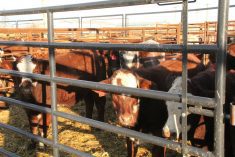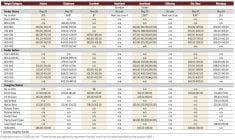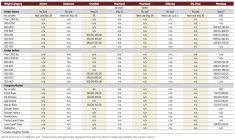Strong prices and movement at the various auction marts across Manitoba are expected to continue in the new year as activity resumes after the Christmas holiday season.
“Indications are that the few cattle that have been publicly traded out there are fully steady,” said Rick Wright, a cattle buyer for Heartland Order Buying Co., adding that demand remains firm.
There will be lots of movement of lightweight cattle when the auctions start up, Wright said. Movement will come as producers get ready for summertime pasture and start to put inventory together, he said. Lightweight cattle prices could advance another five to eight cents per pound more than before the holiday season, he said.
Read Also

Pig transport stress costs pork sector
Popular livestock trailer designs also increase pig stress during transportation, hitting at meat quality, animal welfare and farm profit, Agriculture and Agri-Food Canada researcher says
While there will be some brisk advancement of lightweight cattle, butcher demand will also be strong, he said. Carry-over of butcher cattle was created when some of the supply was not sold at year-end, he said. The carry-over from last year’s supply will provide good-quality meat for packers in January, he added.
Butcher values will start to firm in early February and will continue to advance in the springtime, as strong demand at that time will provide support, Wright said.
Overall, cattle prices should remain strong in the short term, with butcher and lightweight cattle values providing support, he said. Another reason for the positive short-term outlook for cattle prices is that not many local producers purchased additional cattle for resale ahead of spring auctions, he said. Most of the bought slaughter cattle will be kept until pasture is available in the summer, which will add toward the tight supply in the market, he said.
Producers selling most of the calves last fall, creating the tighter supply, will also add to the upward trend in prices, Wright said. Most all of the 300- to 400-pound calves were sold with everything else last autumn, which provided firmness in overall values, he said.
While the Manitoba cattle market looks solid heading into the first part of the new year, some challenges remain.
Issues with feedlot costs have raised some problems, he said; rising barley costs in Western Canada, along with higher corn prices, have caused some uneasiness among producers looking to buy feeder cattle.
However, despite the concerns with feed costs, the continued firm demand for feeder cattle, along with the short supply, could help boost prices to their highest levels in a long time, Wright said.
Loonie adds pressure
The Canadian dollar will also play a role in demand from the U.S. Continued uncertainty in the global economy will affect whether the Canadian currency advances or weakens.
The Canadian dollar affects U.S. demand on two fronts, Wright said. First, the Canadian dollar impacts how much finished meat and cattle is sold to the U.S., which is Canada’s biggest customer for finished cattle. The second factor involves U.S. buyers of Canadian cattle. A tight supply of feeder cattle in the U.S. will see U.S. buyers look to Canada to make up the shortfall.
With the Canadian dollar currently trading around parity, there is little advantage for U.S. buyers to purchase Canadian cattle, Wright said, but if the Canadian dollar falls to levels way below parity, that would spark fresh demand from U.S. buyers.
The Canadian dollar was trading on Jan. 6 at US97.37 cents (US$1=C$1.027).
Despite doubts the Canadian dollar will depreciate further, U.S. demand for Canadian cattle could be amplified by recent drought conditions in the southwestern U.S. over the past year. The drought created US$10 billion in damages, which included crops and cattle, according to industry sources.
The drought led to many of the cattle being killed off, setting back the industry three to four years, Wright said. Manitoba’s small feedlot industry and its central geographical location provides advantages for U.S. buyers to buy Canadian cattle due to lower freight costs, he said.


















